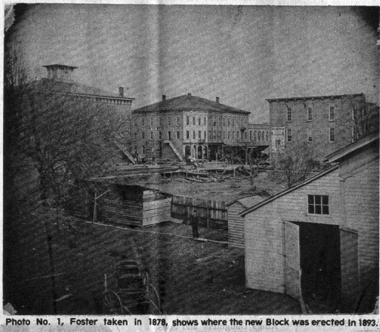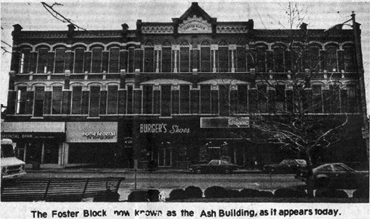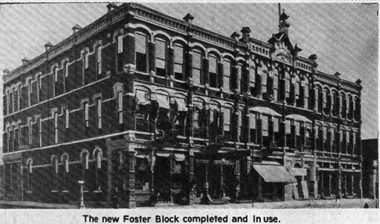April 30, 1981



Picture #1 – Foster taken in 1878, shows where the new Block was erected in 1893. Photo from Ray Dell collection.
Author’s Note: The Feb. 5 Potluck delved into the history of the west side of Main Street from Tiffin to South. Today’s article presents the opposite side of the street.
Just as the first Foster Block and the Foster homes dominated the real estate on the west side of Main, between Tiffin and South, in the early days of Fostoria, the same was true on the east side of the street when the second Foster building was erected.
Fostoria was booming in the 1880’s. The first Foster building on the west side of the street was filled with tenants. New buildings were going up all along the business district to accommodate the town’s growth.
Charles “Calico” Foster, son of C.W. had been active in the development of business and industry in Fostoria. He saw the need for another business block, and was not be outdone by others who had constructed business blocks about that same time.
The accompanying photo No. 1 shows the area selected for the new Foster building. The first Foster building on the opposite side of the street can be seen in the extreme left of the photo.
OTHER HISTORY NOTES
In the center and top of the photo can be seen the corner where Tri-County Bank is now located. The merchants occupying that building were listed in Potluck August 14, 1980. The name Eshelman and Harbaugh Drugs can be seen on that building. That was before the James Crawford store came to that location.
In the extreme right and rear of the photo can be seen the building which still stands on the northeast corner; where Preis Store is now, but back then it was Peter & Fruth Clothing Store…later to become Peter Clothing Co.
In the extreme right and front of the photo is a frame building which may be the one where Nicholas Burtscher conducted a blacksmith shop during that period of Fostoria’s history.
Nicholas Burtscher was the grandfather of Park, deceased and Mrs. E.J. Wright still residing here.
Several years ago, over coffee at Dell’s, Park and I were discussing Fostoria’s early history, and he mentioned that his grandfather had a black- smith shop in that location, but neither of us had seen the photo used with today’s article.
Park had retained much history about early Fostoria from conversations with his father, and others, but unfortunately had not reduced it to writing. I had hoped to retrieve some of it, but Park died before it was accomplished. Both Park and Mrs. Wright related to me how their grandfather walked from Perrysburg to Fostoria at a period in history when that area was all wilderness.
The new Foster Building was built on land in the center of the photo, which was earlier owned by David Hayes, having had a general store at the corner location in 1845. After conducting his business there for a number of years, he moved his store building. The area was vacant until Charles Foster purchased it in about 1866, according to historical data. The 133 feet square plot of ground was bought by Foster for $12,000.
FOSTER BLOCK 1883
It was in 1882 that Foster decided to have the new Foster building erected. he was governor of Ohio at that time, and too busy to attend to construction details, so he appointed Henry Konkle to erect the building. According to old records, he made no contract with Konkle except that he should put it up at though it were his own building.
Konkle and architect J.C. Johnson of Fremont, planned the building in its entirety. Construction started in the spring of 1882 and was completed the next summer…in just 18 months. The building was 136 feet wide (frontage) and 91 feet deep. The completed building cost $45,000.
Messrs, Lindsary and Davis handled all the masonry work. Lindsay was pictured and mentioned in Potluck Feb. 28, 1980. J.T. Ewing had charge of all the carpenter work.
The most elaborate room in the new building was the corner room where Foster & Co.’s Bank was established. The room back of the bank was occupied by Messrs. Fox and Caples, representing glass factories which were here then.. Fox for the window glass plants, and Caples for The Crocker Glass Co.
Completion of the Foster building called for a big celebration in town… parade and all.
BUILDING OCCUPANTS
I’m not sure what the numbering nomenclature was for business houses then, but the system in later years, and still today for the corner location is 200 and all businesses places on that side of the street are even numbers. Consequently, the room next to the bank was (or is) 202, etc.
“202” was first occupied by F.R. Stewart Hardware Store.
“204” was Noah’s Ark General Store
“206” was Ickes & Fall Furniture Store
“208-210” was the Davis and Foster Wholesale Grocery, occupying second and third floor also.
Rooms on the second floor were separated by halls running north and south forming space for office or storage rooms. Offices consisted of Western Union Telegraph Co.; Dr. P.L. Meyers; Attorney J.V. Jones; Dr. Davis, a dentist; North American Normal University. The latter had its classrooms and chapel on the third floor. The school had an enrollment of about 200 young men and women.
Others occupying the third floor were Independent Order of Odd Fellows (IOOF) and Canton Sen-Hanwood…using space for a meeting hall and drill room, library and property room.
The business listed above were the first to occupy the new Foster building. Since city directories were not published early at 1883, which listed streets and the business places by numbers, there is no easy way to determine how long those early tenants stayed in the new building or who followed them. however later in this article readers will find merchant names which came and went through the years that followed in the 1900’s.
BANK FAILED 1893
Historical records reveal that Foster & Co. Bank failed in 1893. They also reveal that about 1895, the location was taken over by a new bank…Seneca Banking Co. with Ira Cadwallader as president, and J.B. Crouse, vice president. Apparently that bank existed until about 1903. It was at that same time (1903) that The Commercial Bank was formed and it started where Seneca Banking had been. At this time I have not discovered data which reveals the reason for Seneca discontinuing business.
The Commercial Bank has been located continuously in the corner room. No. 200 in the Foster building. It is now the uptown branch of the main office on Perry St.
Other businesses with records for longevity in that building were (or are): J.C. Penney Co. started in 1916 in rooms No. 208-210 with E.R. Kellogg as manager. the store closed in February 1979 and now has an order-branch only in the Plaza.
Pastime Billiard Parlor started in “204” in about 1914 by Johnny Williams, and continued until 1957. Williams had a billiard parlor at the northeast corner of Main and Center in 1899 according to an old directory, but I can’t justify that location.
Dr. W.H. Pelton, dentist had offices on the second floor about the bank from about 1908 until approximately 1955 or 1956. During that entire time Dr. Pelton and his wife Madeline also lived in quarters adjacent to his office.
REMEMBER?
Older readers will remember both of the Peltons…him for his excellence in making dentures which fit perfectly…also for the hunting dogs which were kept in their living quarters, and took for rides in their open-type touring car. Mrs. Pelton will be remembered for her beauty in her younger days. She was considered Fostoria’s most beautiful lady. She was a journalist and collector of antiques.
Steve Hyte, the barber, had his shop under the Commercial Bank from about 1927 to 1951…quite a longevity record.
A new business to Fostoria’s uptown in 1943 was Sherwin Williams. It located in room “206” and has been there continuously, thus, also establishing a longevity record for that area.
Other businesses, professionals and miscellaneous categories, which have been located in the Foster building are:
“202” – The Mahony Hardware Co., Swint Parks Hardware, Direct Furniture Co., Basket Market, Kessel’s Women’s Clothing, Fabric Center, H & R Block, Home Federal.
“204” – C.C. Few, barber; Pete Katsaros Shoe Shine; Howard – Andes, barbers; Clinton Stocker, barber…in the same room with Pastime Billards; Schiff Shoe Store and Burger Shoe Store. In the case of the latter, they have established a good record for being in that block…part of it being directly across the street. Altogether they have been selling shoes from that area for nearly 40 years. Cory Mfg. Co. (Howard Cory) Overalls Mfgrs, was also located at “204” at one time.
“206” – Strand Theatre, Fostoria Amusement co., The Book Shop, Bellreich’s Beehive Store (John and J.L. Ballreich).
STRAND THEATRE
And what do I remember about Strand? Even before I was old enough to go to the movies alone, I remember being in that “picture show”, sitting on the lap of one of my older relatives, watching Theda Bara and Rudolph Valentino playing the lead roles…maybe it was “Sheik of Araby”, I’m not sure. How do I recall that? I don’t know. I have always been able to recall events from very early childhood.
“208” – H.E. Kimball Shoe Store appeared in one directory as operating their store in that location. Perhaps if was an error and should have been
“206”, since Penney Store was “208-210” for many years.
“208-210” – Currently those rooms are vacant and have been since J.C. Penney closed their retail stores and operate a mail-order desk only in the Plaza. Stores that occupied those rooms before Penney are listed earlier in this article.
OTHERS: The Loyal Order of Moos, Joseph Gabriel -Tailor, Bethel Baptist Church…all occupied space on the upper floors of that block, in addition to those listed elsewhere.